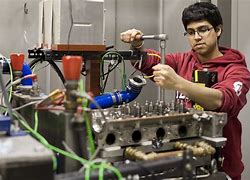Top 20 Mechanical Engineer Fresher Interview Questions
Table of Contents
Top 20 Mechanical Engineer Fresher Interview Questions
1. Can you explain the fundamental principles of thermodynamics?
Example – “The study of energy and heat transfer is a subject of thermodynamics. It has four basic principles: the first law (conservation of energy), the second law (entropy increase in isolated systems), the third law (entropy approaches zero at absolute zero), and zeroth law (thermal equilibrium between objects in contact).”
2. Describe the difference between stress and strain?
Example – “Stress is the internal resistance of a material to deformation, while strain is the measure of how much a material deforms under stress. Stress is force per unit area, while strain is the ratio of deformation to the original length.”
3. What is the difference between a fluid and a solid?
Example – “A solid has a definite shape and volume, while a fluid takes the shape of its container and has a variable volume. Fluids can be further classified as liquids and gases based on their compressibility.”
4. Explain the working principle of a four-stroke internal combustion engine?
Example – “A four-stroke engine goes through four phases: intake, compression, power, and exhaust. It intakes air-fuel mixture, compresses it, ignites it, and expels the exhaust gases. This process repeats in a cycle.”
5. What is the purpose of a differential in an automobile?
Example – “The differential distributes power from the engine to the wheels, allowing them to rotate at different speeds when the vehicle turns. It also plays a role in torque distribution between wheels.”
6. How does a heat exchanger work, and what are its applications?
Example – “A heat exchanger transfers heat between two fluids without mixing them. It has applications in HVAC systems, refrigeration, and power plants, where heat transfer is essential.”
7. Can you explain the concept of ‘Young’s Modulus’ in material science?
Example – “Young’s Modulus is a measure of a material’s stiffness and its ability to withstand axial loads without permanent deformation. It quantifies the ratio of stress to strain in a material under tension or compression.”
8. Describe the types of machining processes used in manufacturing?
Example – “Turning, milling, drilling, grinding, and electrical discharge machining (EDM) are examples of common machining techniques. Each method is suitable for particular materials and applications.”
9. What is the difference between a gear and a pulley in terms of mechanical systems?
Example – “Gears transmit motion between two shafts by meshing teeth, while pulleys use belts to transfer motion. Gears provide precise speed and torque ratios, while pulleys are simpler and suitable for different applications.”
10. How does a hydraulic system work, and what are its advantages?
Example – “Hydraulic systems use fluids (usually oil) to transmit power. They work on the principle of Pascal’s law, where pressure applied to a confined fluid is transmitted undiminished. They are known for their high power density and ability to multiply force.”
11. Explain the importance of CAD (Computer-Aided Design) in mechanical engineering?
Example – “CAD software allows engineers to create detailed and accurate 2D and 3D models of mechanical components and systems. It enhances design efficiency, reduces errors, and facilitates collaboration.”
12. What are the primary methods for non-destructive testing (NDT) of materials?
Example – “NDT methods include ultrasonic testing, radiographic testing, magnetic particle testing, dye penetrant testing, and visual inspection. These techniques help identify defects in materials without damaging them.”
13. Discuss the concept of ‘Lean Manufacturing’ and its benefits?
Example – “Lean manufacturing aims to eliminate waste in production processes, such as excess inventory, overproduction, and inefficient workflows. Its benefits include reduced costs, improved quality, and shorter lead times.”
14. What is the significance of the ‘Reynolds Number’ in fluid mechanics?
Example – “The Reynolds number is used to predict the flow regime of a fluid (e.g., laminar or turbulent). It helps engineers design efficient pipes, channels, and aircraft wings by understanding the fluid behavior.”
15. How do you approach a problem involving material selection for a specific engineering application?
Example – “Material selection involves considering factors such as mechanical properties, cost, availability, environmental impact, and manufacturability. A systematic approach involves evaluating these criteria and choosing the most suitable material.”
16. Describe the difference between static and dynamic balancing in rotating machinery?
Example – “Static balancing involves ensuring that the center of mass is on the axis of rotation, while dynamic balancing also considers the distribution of mass to eliminate vibrations during rotation.”
17. What safety measures should be followed when working with heavy machinery or in a manufacturing environment?
Example – “Safety measures include wearing appropriate personal protective equipment (PPE), following lockout-tagout procedures, conducting regular equipment inspections, and adhering to safety protocols to prevent accidents.”
18. How does a refrigeration cycle work, and what is its role in HVAC systems?
Example – “The refrigeration cycle involves the compression, condensation, expansion, and evaporation of a refrigerant to transfer heat. In HVAC systems, it is used to maintain desired temperatures in buildings.”
19. Explain the concept of ‘tensile strength’ in materials science?
Example – “When a material is stretched or pulled to its breaking point, it has reached its tensile strength. It is a critical property for materials used in applications where stretching forces are involved.”
20. How do you stay updated with the latest trends and advancements in the field of mechanical engineering?
Example – “To stay updated, I regularly read industry publications, participate in online forums and communities, attend workshops and conferences, and engage in continuous learning through online courses and certifications.”




